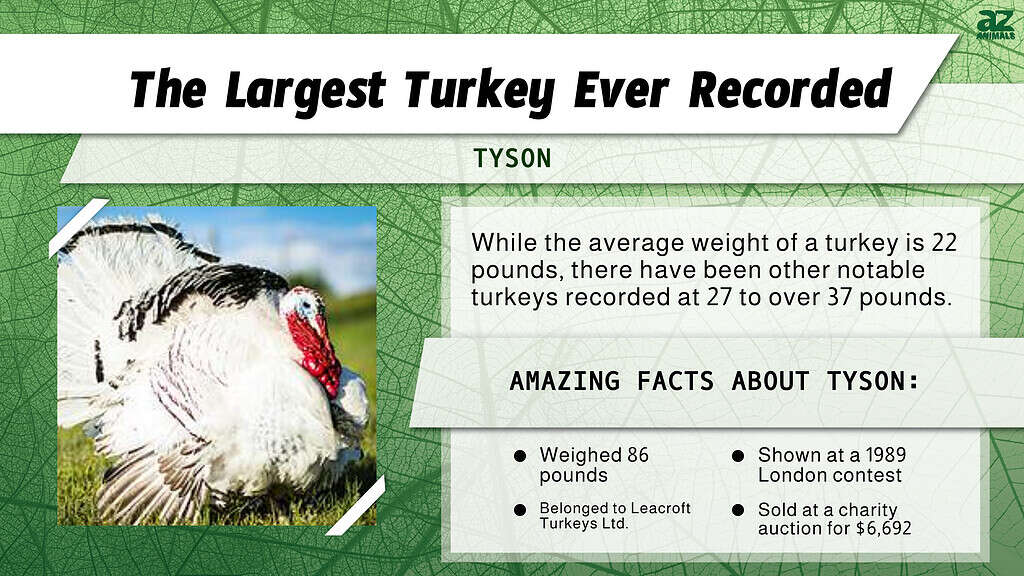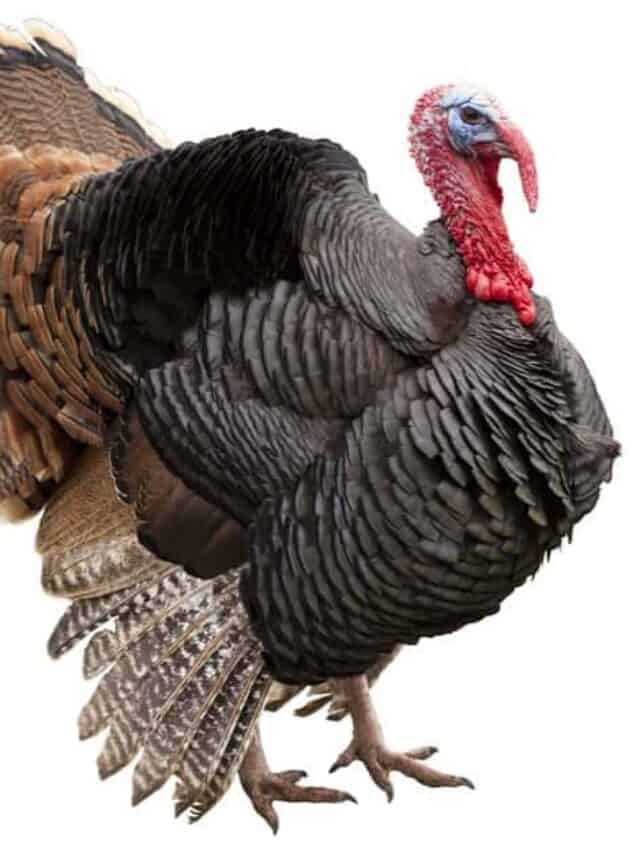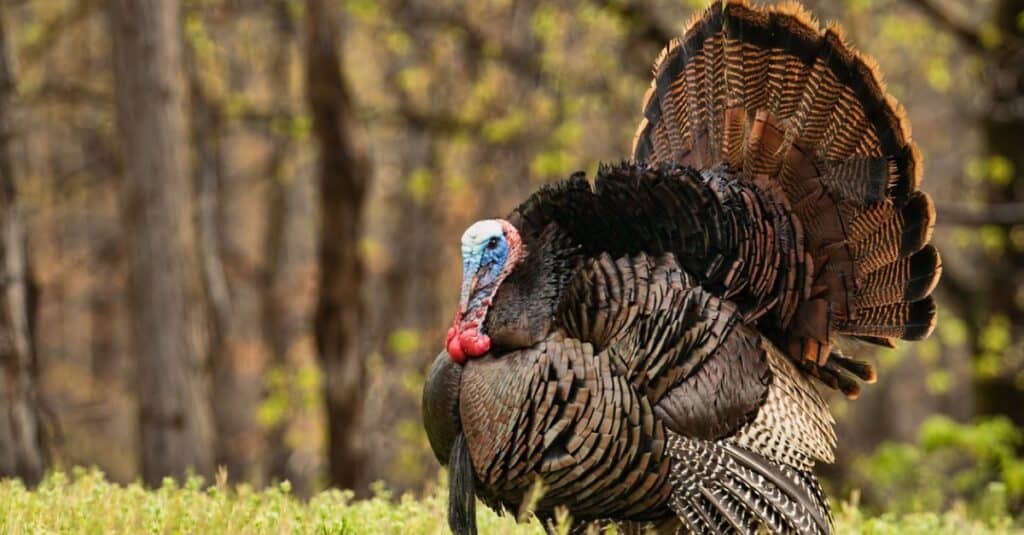
Introduction
Turkeys aren’t just something seen at the Thanksgiving dinner table once a year. In fact, turkeys are fascinating creatures, and people don’t know much about them besides how to cook them. Turkeys come in all shapes, sizes, colors, and breeds. They are native to Central America and North America; some species have even originated in Spain, England, and beyond. While some hunters might boast about the size of a turkey they’ve killed, theirs are no match for the 86-pounder discovered in 1989! This single turkey holds the record for the largest turkey to ever strut the earth. It wouldn’t be an over-exaggeration to state that this turkey would make one crazy Thanksgiving meal! Find out who this tom is and why he still holds his record over 30 years later!
Background on Turkeys

Various colors are present on the turkey’s body and feathers, including red, blue, green, white, and brown.
©Jim Cumming/Shutterstock.com
There are two main types of turkeys: the typical turkey and the ocellated turkey. Wild turkeys, which are native to North America, began to be domesticated by Native Americans but were eventually brought to Europe by Spanish traders and explorers. Originally, turkeys were bred for their beautiful feathers. Over time though, they were bred for meat production.
Ocellated turkeys are related to common turkeys but differ in location. You can find ocellated turkeys within a 50,000 square mile range in the Yucatán Peninsula of Mexico, and in northern and western regions of Belize and Guatemala. As far as characteristics of these birds go, ocellated turkeys are almost identical to regular turkeys from North America. While researchers considered them as possibly being their own genus at one time, further study showed the differences were too small. Another difference is that since 2009, the ocellated turkey has been considered Near Threatened by the IUCN. Common turkeys, on the other hand, are not threatened.
Various colors are present on the turkey’s body and feathers, including red, blue, green, white, and brown. Often, their feathers are iridescent, meaning they shift from one color to another depending on angle and lighting. They also have a snood, a long piece of flesh that begins at their head and dangles over their bill. Turkeys have a wattle which protrudes from their neck.
In Europe, Turkey is a typical dish at Christmas. In the United States, turkey is known as a Thanksgiving dish. Therefore, much of the meat industry produces turkey seasonally, and productions peak around those holidays. In the United States, turkey is readily available in several forms, including deli meat, turkey filets, or turkey substitutes like turkey burgers or turkey bacon.

The snood is a long piece of red skin that dangles over a turkey’s beak.
©veleknez/Shutterstock.com
Turkey Diet
A wild turkey’s diet consists of insects, seeds, small reptiles or amphibians on occasion. Wild turkeys can fly, but they cannot fly long distances. When a wild male turkey desires to mate, it will demonstrate several behaviors. For instance, it will spread its tail and shake its quills. It will also make its famous gobbling sound that many people associate with the animal. After mating, female turkeys will lay between five and eight eggs at a time, hatching in approximately one month.
Ocellated turkeys originate in Central America and are smaller than the typical turkey. Ocellated turkeys are not domesticated like the common turkey but also bear color markings, which include blue and yellow. Most ocellated turkeys do not look like North American wild turkeys. In fact, they resemble peacocks with their bright colors and smaller appearance.
Average Size of a Turkey
Male turkeys, referred to as toms, measure around 50 inches and usually weigh about 22 pounds. Female turkeys, or hens, typically weigh half the amount that toms weigh. However, turkeys that have been domesticated for meat production often weigh more.
Large Turkey Breeds
Some turkey breeds can grow very large, especially when they are domesticated. Several large turkey breeds are listed below, including weight and characteristics.
- The Standard Bronze turkey is one of the largest breeds, weighing 25 pounds. Breeding between European domestic turkeys and wild turkeys produced this breed, and they are often used for meat production.
- White Holland turkeys originated in Holland and are a cross between white turkeys from Europe and North American turkeys. They weigh between 20 and 30 pounds. While they used to be a principal source of meat, White Holland turkeys are now endangered.
- Bourbon Red turkeys are not as large as the White Holland or the Standard Bronze, weighing between 12 and 23 pounds. Bourbon Reds come from Kentucky, and their meat is highly sought-after.
Biggest Turkey Ever Recorded
On December 12, 1989, the biggest turkey ever recorded weighed 86 pounds at a competition this stag turkey won in London. Its weight was equivalent to a baby rhino. The turkey named Tyson belonged to Leacroft Turkeys Ltd. It was eventually sold for $6,692 at a charity auction.
Other Massive Turkeys
While no turkey has been able to rival Tyson in weight, hunters have reported some notable weights of other wild turkeys. Below is a list of five of the heaviest turkeys recorded by hunters in the United States.
- An Osceola turkey weighing 27 pounds was killed by Rosita Morris in Polk, Florida.
- In April of 2002, Scott J. Crofcheck reported killing a 29.375-pound Gould’s turkey in the southwestern United States.
- In 2006, George Connors killed a Merriam’s turkey that weighed 31.56 pounds.
- A Rio Grande turkey that weighed 37.125 pounds was killed by Jacob Braught in Oregon in April of 2002.
- David Cody killed a 37.61-pound Eastern turkey in Lyon, Kentucky, in April of 2015.
Turkey Hunting

Turkey hunting is heavily regulated to ensure turkey populations are not threatened.
©iStock.com/Jens_Lambert_Photography
While wild turkey populations have been threatened in the past, many efforts and regulations have helped increase their population back to stable levels. Turkey hunting is heavily regulated to ensure turkey populations are not threatened.
Male turkeys will appear larger and have a brighter color pattern than female turkeys. One common mistake hunters make is assuming that a turkey is male because it has a beard. Some females also have beards, so other observations should be made to affirm the gender of the turkey when hunting. One excellent way to identify turkeys for hunting is to scout them before the turkey-hunting season begins. This way, a hunter will be ready to find the right turkey to target when the turkey season rolls around.
Turkey Sounds
Wild turkeys can make many distinct sounds, but many of them are difficult to distinguish from one another when hunting. Wild turkeys make three sounds: gobbles, clucks, and yelps. Hunters should not use gobbles to call turkeys for several reasons. First, the usage of a gobble can cause other hunters within the area to be aware of where a specific hunter is waiting. In addition, gobble calls might attract aggressive male wild turkeys, which drive away other birds.
Plain yelps are a standard and effective way of calling turkeys. Hens typically yelp to call males during mating season, so this strategy is a satisfactory way of bringing a male wild turkey closer to a hunter. On the other hand, Cluck sounds are used to attract male wild turkeys who are looking for a hen to mate with.
Camouflage
Wild turkeys reside near trees, grasses, and water sources. Due to their habitat configuration, dressing in the appropriate camouflage is necessary. Turkeys have superior eyesight, so the right facade will be essential to take home one of these birds. Furthermore, hunters must acquire a gun or a bow to hunt a male wild turkey. Venturing to find wild turkeys in areas that combine all three is a good strategy for hunters.
The most critical consideration in turkey hunting is season and regulations. Different states have different seasons and bag limits for hunting wild turkeys. Doing thorough research on state regulations is crucial to following the law and protecting wild turkey populations. In addition, hunting licenses are necessary before a hunter goes after a wild turkey.
Turkey World Records
While size is a large component of what makes a turkey hunt successful, other unique wild turkey characteristics have been both recognized and record-breaking. Some records reported by the National Wild Turkey Federation are described below.
13 Beards
A turkey shot by an 11-year-old boy named Tyler Blake Mumpower had 13 beards attached to it. The longest beard measured 10 inches, and the beards measured 78.9375 inches when combined. The turkey weighed 22 pounds and was killed in Pennsylvania.
Longest Beard
Cody May shot and killed the turkey with the longest beard in New Boston, Texas. The Eastern turkey’s beard measured 22.5 inches in length. Although the beard eventually wore away to 17.5 inches at the second measurement, the first measurement was accepted and reported as a world record for turkey beard length.
Longest Spurs
In 2017, a turkey was killed in North Carolina by Willard Dills. This tom broke the record for the longest spurs ever recorded on a turkey. The spurs measured 2.5625 inches.
How Big Should a Thanksgiving Turkey Be?
The size of the turkey served on Thanksgiving depends on several factors. For one, the number of people seated at the dinner table determines the size of the turkey. It is recommended that each person receive a 1.5-pound share of the turkey. Therefore, if someone is serving eight people a Thanksgiving dinner, they should purchase a turkey that weighs between 12 and 15 pounds.
However, if the party is smaller, the turkey should be smaller. The only issue is that the meat-to-bone ratio is smaller for turkeys under 12 pounds. In this case, it is recommended that each guest receive two pounds of turkey. For a party of five, for example, the turkey should weigh 10 pounds when purchased. Something interesting to note is that if Tyson the turkey was served for Thanksgiving dinner, he could feed up to 57 people!

Turkeys can see better than humans.
©iStock.com/Robert Winkler
What Kind of Turkey Should be Served at a Thanksgiving Dinner?
The turkey breed best served for Thanksgiving all depends on taste. For instance, the Broad Breasted White turkey is extremely popular and large, with a high meat-to-bone ratio. The Broad Breasted White turkey is the choice if white meat is preferred.
On the other hand, wild and heritage-breed turkeys have a more authentic flavor. Some heritage breeds include the Standard Bronze, Bourbon Red, White Holland, and Narragansett turkeys. These turkey breeds are considered more natural and organic than the Broad Breasted White, but they produce less white meat. Unfortunately, heritage and wild turkey breeds are smaller than those that are most popular. Therefore, a heritage or wild turkey might be the right fit if the Thanksgiving dinner party is small.
How Much Turkey Do Humans Consume?
It may (or may not) shock you to know that Americans alone consume 1.4 billion pounds of turkey a year. At Thanksgiving time, around 46 million turkeys give their lives for our yearly celebration. Also, the consumption of turkey in the US in 2020 was estimated at 16 pounds per capita. That’s a heck of a lot of turkey!
While the United States ranks #1 for turkey consumption, turkey is a popular meat choice all over the world. Countries that follow right behind the US in feasting on turkey include: Brazil, Germany, France, Italy, Russia, Spain, Mexico, the UK, and Canada. It’s estimated that by 2025, the global market of turkey consumption will reach 6.7 billion tons!
Lifespan: How Long Do Turkeys Live?
Obviously, if it ends up on your table for Thanksgiving dinner, the turkey didn’t make it that long. But, how long do turkeys actually live? The average lifespan of a turkey in the wild is only 3-5 years. In captivity, turkeys who are well-taken care of can live 10 years. What about turkeys whose whole existence is to feed humans and animals? Hens are ready for slaughter at the young age of 14-16 weeks, while male turkeys may live up to 19 weeks.
The photo featured at the top of this post is © Sean R. Stubben/Shutterstock.com
Sources
- Niklas, Available here: https://weightofstuff.com/12-things-that-weigh-around-80-pounds-lbs/
- Britannica, Available here: https://www.britannica.com/animal/turkey-bird
- National Wild Turkey Federation, Available here: https://www.nwtf.org/content-hub/turkey-hunting-101
- Kayla Walden, Available here: https://farmflavor.com/lifestyle/food-for-thought/top-9-turkey-breeds-found-on-farms-across-the-united-states/
- Guinness World Records, Available here: https://www.guinnessworldrecords.com/world-records/70769-heaviest-turkey
- Phil Bourjaily, Available here: https://www.fieldandstream.com/hunting/world-record-turkeys/
- Martha Stewart, Available here: https://www.marthastewart.com/274812/turkey-tips?slide=6638c6bd-1f71-43ce-81bd-5fc3e19ca986#6638c6bd-1f71-43ce-81bd-5fc3e19ca986
- D'Artagnan, Available here: https://center-of-the-plate.com/2017/10/24/gobble-it-up-heritage-turkey-for-thanksgiving/#:~:text=The%20Modern%20Turkey&text=The%20most%20popular%20breed%20is,and%20meat%2Dto%2Dbone
FAQs (Frequently Asked Questions)
Can turkeys fly?
Turkeys can fly very short distances, usually up to ¼ of a mile.
What is the average weight of a turkey?
On average, turkeys weigh approximately 22 pounds. However, weight depends on breed and level of domestication.
What kinds of turkeys exist?
The two main types of turkeys are the ocellated turkey and the common turkey. However, there are other distinct breeds of turkey, which are organized into smaller groups.
Thank you for reading! Have some feedback for us? Contact the AZ Animals editorial team.






